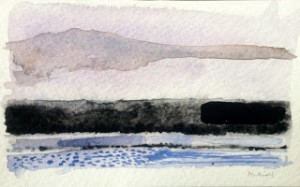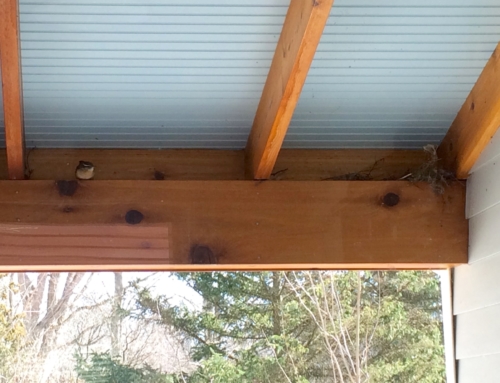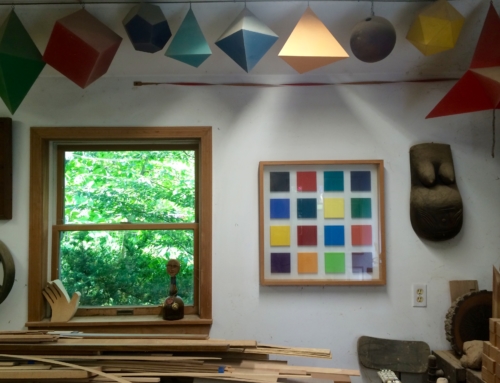 Anthologies, like art galleries and wooded trails, invite exploration. I rarely read them front to back. Instead, I meander. And that’s how I discovered this exquisite watercolor and ink study in Poetry in Michigan/Michigan in Poetry (a 2014 Michigan Notable Book from New Issues Press). It felt at once familiar and foreign. At first the long bruise across the top half of the watercolor paper was clouds, the ink wash below it, a shoreline of trees, shadowed and lit, and then the black rectangle seemed to be moving in from the right, like a train–along a river, which is what the dapples and streaks of blue across the bottom became. My eyes moved back up to the top left, and because I love mountains, crave being in them, and wish I knew them better, the clouds morphed into mountains and my imagination launched me into alpine places I have known, and long for. And then my imagination was off and running.
Anthologies, like art galleries and wooded trails, invite exploration. I rarely read them front to back. Instead, I meander. And that’s how I discovered this exquisite watercolor and ink study in Poetry in Michigan/Michigan in Poetry (a 2014 Michigan Notable Book from New Issues Press). It felt at once familiar and foreign. At first the long bruise across the top half of the watercolor paper was clouds, the ink wash below it, a shoreline of trees, shadowed and lit, and then the black rectangle seemed to be moving in from the right, like a train–along a river, which is what the dapples and streaks of blue across the bottom became. My eyes moved back up to the top left, and because I love mountains, crave being in them, and wish I knew them better, the clouds morphed into mountains and my imagination launched me into alpine places I have known, and long for. And then my imagination was off and running.
Don’t we all love when a piece of visual art resonates personally like this?
I’d already spent quite a lot of time with the image when my gaze strayed to the text on the page: Dark Spaces, Meridith Ridl. Meridith! Meridith whose eloquent graphite renderings of birds, fabric, plants, as well has her inventive 3D work, have enchanted me in person. I went to her blog and viewed other studies in the series, which it happens was made, “amid rock and mist, mountains and sea, of the Icy Strait in Alaska.” Those may be mountains after all.
Encouraging you to spend some quality time with the next painting that seizes your imagination. . .
Full disclosure: I have a poem (born in the Saugatuck Dunes) in Poetry in Michigan/Michigan in Poetry, and that’s why I had the good luck of having the book land on my desk before most people had had a chance to see it. It’s a fund raiser for New Issues Press, with 95 poems and 46 fine-art images. Dog Ears Books, in Northport, Michigan, is hosting several contributors for a reading on Friday, June 13, at 7. I hope to see some of you there.
Click here to view more of Meridith Ridl’s work.
And here to read more about the book, edited by William Olsen and Jack Ridl.









Leave A Comment